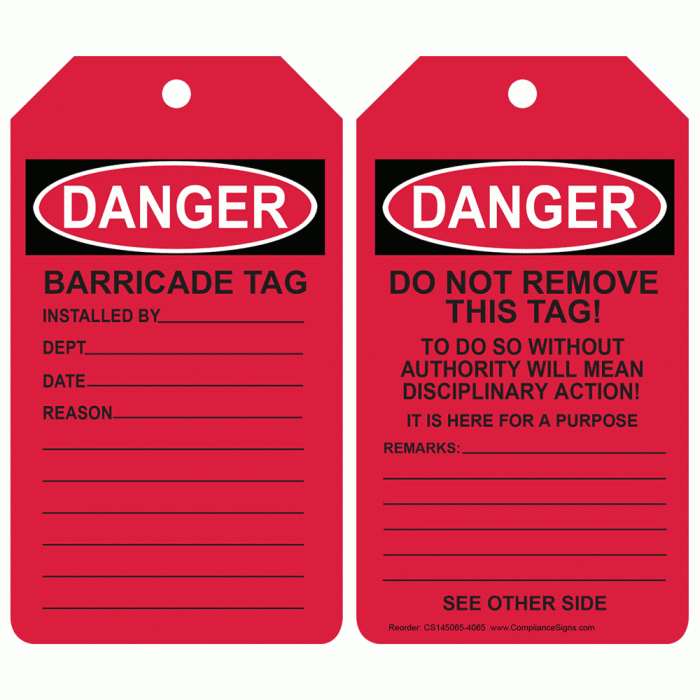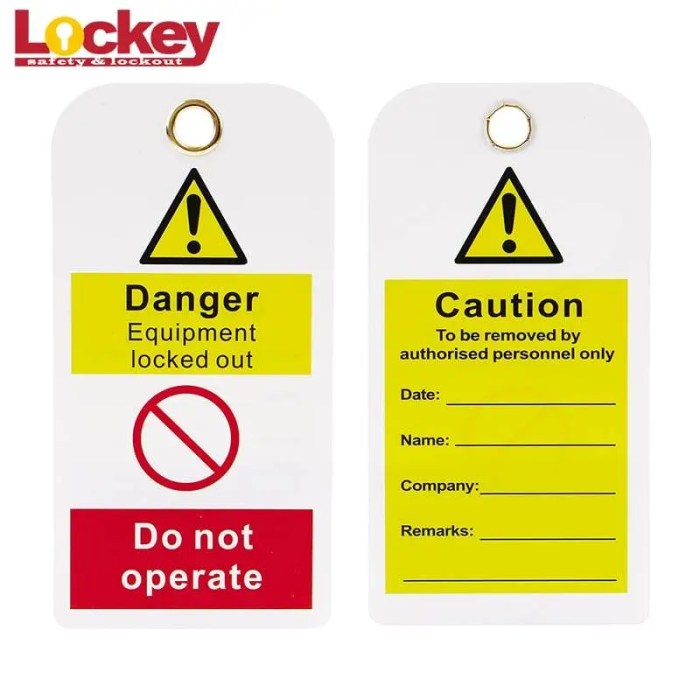Safety tags are a permanent warning indicator – Safety tags, as permanent warning indicators, play a crucial role in preventing accidents and injuries. Their conspicuous presence serves as a constant reminder of potential hazards, ensuring that individuals remain vigilant and adhere to safety protocols.
These tags are essential components of comprehensive safety measures, providing clear and concise information about potential risks and the appropriate precautions to be taken.
Introduction: Safety Tags Are A Permanent Warning Indicator

Safety tags serve as permanent warning indicators, providing vital information about potential hazards in workplaces and public areas. These tags are essential for preventing accidents and injuries by alerting individuals to specific risks and guiding them towards safe behavior.
The concept of a permanent warning indicator is crucial in safety protocols. Unlike temporary signs or verbal warnings, safety tags offer a consistent and reliable source of information that remains visible and accessible over time. This ensures that individuals are continuously reminded of potential hazards and can take appropriate precautions.
Importance of Safety Tags

Safety tags play a critical role in preventing accidents and injuries by providing clear and immediate warnings about potential hazards. These tags effectively communicate information about:
- Electrical hazards
- Chemical risks
- Physical dangers
- Biological threats
By highlighting these hazards, safety tags enable individuals to make informed decisions about their actions and avoid situations that could result in harm. Additionally, permanent warning indicators enhance safety measures by providing a constant reminder of the risks present, even in the absence of direct supervision.
Types of Safety Tags

There is a wide range of safety tags available, each designed for specific applications and hazards. Common types include:
- Danger Tags: Indicate immediate and severe hazards that can cause serious injury or death.
- Warning Tags: Alert individuals to potential hazards that could result in moderate to severe injuries.
- Caution Tags: Provide information about minor hazards that may cause minor injuries or property damage.
- Lockout Tags: Used to prevent machinery or equipment from being operated during maintenance or repairs.
- Safety Inspection Tags: Indicate that equipment has been inspected and is safe for use.
Each type of safety tag has its own specific color, shape, and wording, ensuring clear and easy identification of the associated hazard.
Placement and Visibility of Safety Tags
Proper placement and visibility of safety tags are essential for their effectiveness. Tags should be placed:
- In close proximity to the hazard
- At eye level for easy visibility
- In well-lit areas
- Away from obstructions
Standardized locations and clear labeling are also crucial. Consistent placement of tags ensures that individuals can quickly locate and understand the warnings. Proper labeling provides specific information about the hazard, including its nature, severity, and any necessary precautions.
Maintenance and Inspection of Safety Tags
Regular maintenance and inspection of safety tags are essential to ensure their continued effectiveness. Procedures should include:
- Visual inspections for damage or fading
- Replacement of tags that are damaged or illegible
- Verification that tags are properly placed and visible
Neglecting tag maintenance can compromise their ability to provide adequate warnings, potentially leading to accidents and injuries. Regular inspections and prompt replacement of damaged tags ensure that safety information remains accurate and accessible.
Compliance and Enforcement
Safety tags are often required by law and regulations. Non-compliance can result in penalties and legal consequences. Compliance with safety tag requirements includes:
- Using appropriate tags for the specific hazard
- Proper placement and visibility of tags
- Regular maintenance and inspection
Enforcing safety tag regulations is essential for ensuring workplace safety and preventing accidents. Regular inspections and audits can help identify and address non-compliance issues.
Case Studies and Examples
Numerous case studies demonstrate the effectiveness of safety tags in preventing incidents and injuries. For example, a study by the National Safety Council found that the use of lockout tags during maintenance procedures reduced accidents by 50%. Another study by the Occupational Safety and Health Administration (OSHA) showed that the implementation of a safety tag program resulted in a 25% decrease in workplace injuries.
These examples highlight the significant impact that safety tags can have on preventing accidents and ensuring workplace safety. By providing clear and permanent warnings, safety tags empower individuals to make informed decisions and take appropriate precautions to protect themselves and others.
Common Queries
What are the different types of safety tags?
Safety tags come in various types, including danger tags, caution tags, warning tags, and lockout tags, each with specific applications and usage.
Where should safety tags be placed?
Safety tags should be placed in conspicuous locations, such as on equipment, machinery, or hazardous areas, ensuring maximum visibility and effectiveness.
Who is responsible for maintaining and inspecting safety tags?
The responsibility for maintaining and inspecting safety tags typically falls upon designated safety personnel or individuals trained in safety protocols.